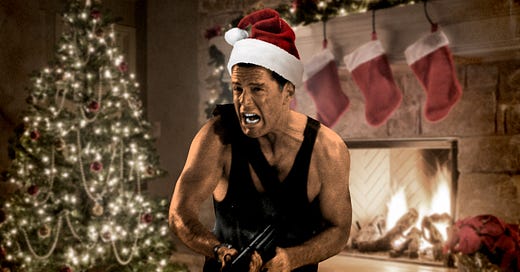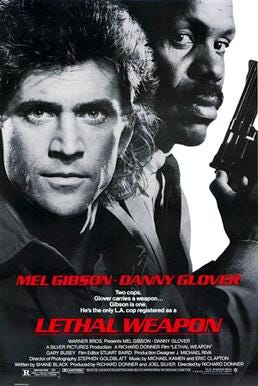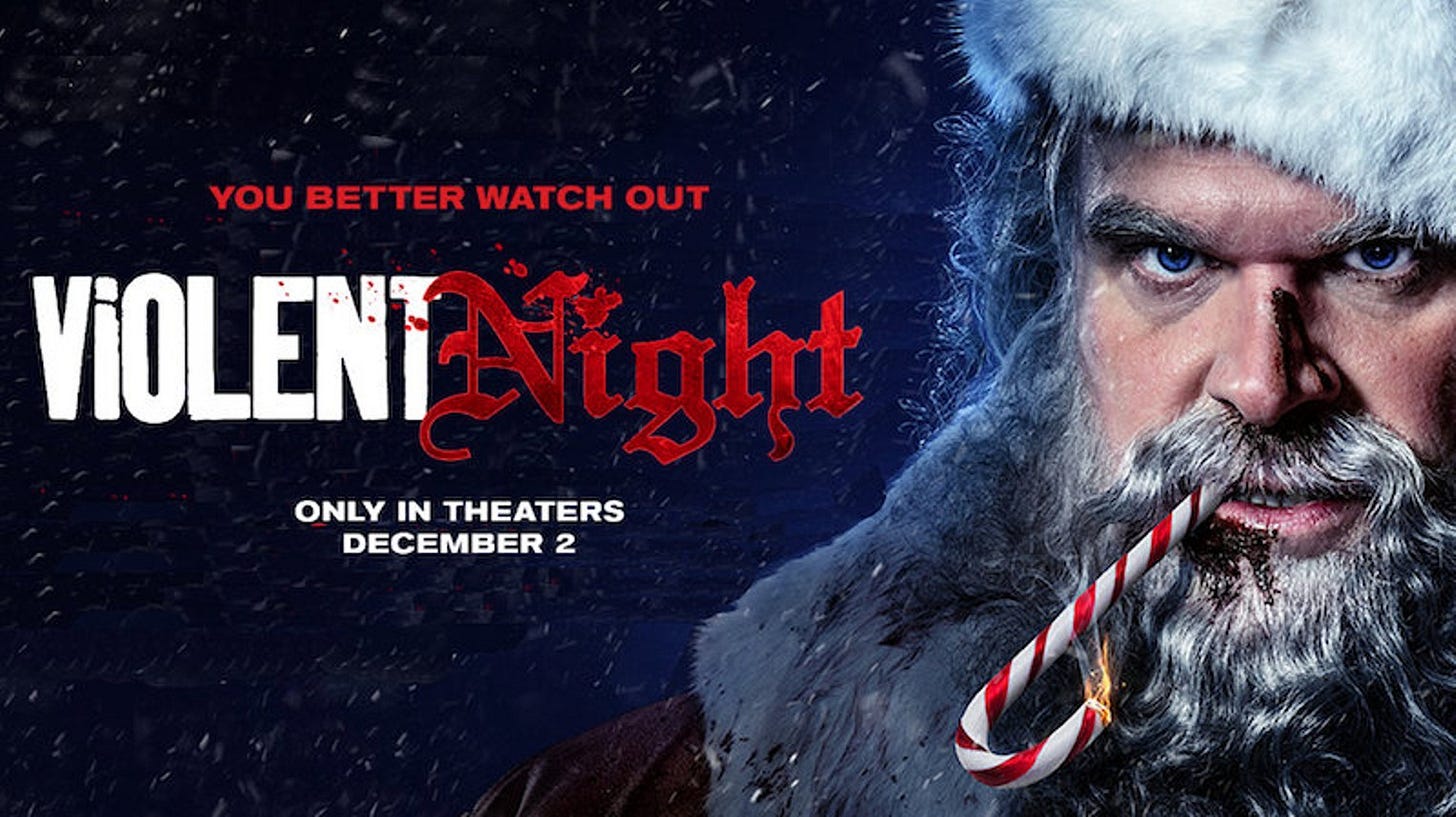To get it out of the way, Die Hard is a Christmas film through and through beyond a shadow of a doubt. I will be explaining why exactly later on but I wanted to be up front about this bona fide holiday classic and drive off anyone who would dare refute it.
Last week’s post examined the intersection of Christmas stories and horror, but now we turn to another slightly unorthodox mashup of genres—action and Christmas stories. Popular, traditional Christmas movies in America usually lean towards cozy dramas or comedies with films like It’s A Wonderful Life (1946), White Christmas (1954), Home Alone (1990), Elf (2003), and more recently Daddy’s Home 2 (2017) in my family’s yearly lineup. There is also the propensity to have holiday films with a mostly family friendly slant perhaps for the dual purpose of fostering traditions of gathering around the “Big Babysitter” and generating revenue from tickets and DVD sales purchased by families. While the movies discussed in this post veer away from the more traditional or expected qualities of Christmas movies, they still carry the heart and soul of the season in their narratives.
To break down the core elements of Christmas stories simply, I will use what I call the Christmas Carol virtues. Given that Dickens’ immortal classic embraces the thesis of the holiday, it makes sense to use it as a model for examining how and why the following films celebrate the spirit of the season. There are innumerable and overlapping qualities that could be pointed out in Christmas Carol, but to keep it simple I will be sticking with three—
The denial of greed: Scrooge begins A Christmas Carol as a miserly old man whose only identifiable emotions are greed and disgust (much like a certain serial killer in New York), with his major motivation for living being to save and scrape as much material wealth as possible, especially to others’ detriments. One major lesson he learns throughout the story is how to share the wealth he obtained and hoarded. Since Christmas in the modern day can inspire avarice, this is a strong moral to encourage moderation or even outright denial when it comes to obtaining gifts during this time of year, instead favoring to give.
The breaking of earthly chains: Referring to the condition of Jacob Marley’s ghost, this virtue may seem similar to the first but it refers more so to the emotional and social attitudes that “forge” chains onto people like Scrooge who resist getting in the spirit of the season. At the end of A Christmas Carol, Scrooge declares, “ ‘I am as light as a feather…’ ” upon waking from his experience with the three ghosts, signifying the liberation from the chains Marley warned him of. This comes following the dark vision of his own mortality, but rather than being shocked into terror and total meekness, Scrooge becomes elated as he fully embraces the more ethereal joys that come with abandoning over concern for earthly realities and constructed anxieties. His literal spirit (i.e. his soul) is free to guide him towards more charitable pursuits.
The acceptance and love of family and companionship: By the end of A Christmas Carol, Scrooge has come to realize that he was indeed not alone and reaches out to the people he wronged or slighted to not merely ask their forgiveness but invite them into his new life as a changed man. Dickens makes it clear that this doesn’t end after Scrooge’s fateful Christmas with the ghosts, but remains a virtue that Scrooge upholds for the rest of his life. As Frank Cross says in Scrooged (1988),
“If you believe in this spirit thing, the miracle will happen and you’ll want it to happen again tomorrow. You won’t be one of these bastards who says, ‘Christmas is once a year and it’s a fraud’—it’s not! It can happen everyday, you’ve just got to want that feeling and if you like it and you want it you’ll get greedy for it. You’ll want it everyday of your life and it can happen to you.”
With these virtues in mind, we can begin our examination of three holiday action movies in order of years they released: Lethal Weapon (1987), Die Hard (1988), and Violent Night (2022).
Lethal Weapon
Although the backdrop of Christmas in the first Lethal Weapon may seem superficial, there are still enough themes in its narrative that qualify it as a Christmas movie. In following the Christmas Carol virtues model, our deuteragonists Martin Riggs (played by Mel Gibson) and Roger Murtagh (played by Danny Glover) deny greed in part by thwarting the schemes of Shadow Company as they run a covert heroin trade with highly-trained members and leaders from the U.S.’s own military. The breaking of earthly chains section mainly manifests in Riggs’ character arc as he struggles with suicidal thoughts and actions following the death of his wife. He believes he has nothing left to live for as the burdens of grief weigh him down, but through his partnership with Murtagh and mission to eliminate Shadow Company he breaks his own chains to save the day. Murtagh as well manages to overcome his doubts and anxieties of age in spite of his famous quip, “I’m too old for this shit.” In the end, Riggs and Murtagh find joy in companionship by sharing a Christmas dinner with Murtagh’s family. The Christmas themes are rather sparse in Lethal Weapon, but it can still be slanted as a holiday watch when you need a break from the saccharine Hallmark specials and want to see LA cops fighting corruption to save the spirit of the season.
Die Hard
Before I was allowed to watch R-rated movies, hearing my parents call Die Hard a Christmas movie baffled me. I didn’t know much about the plot before I eventually saw it but naturally assumed it to simply be a violent action movie. The first time I watched it was in mid-February, so I was fresh out of holiday spirit. In more recent viewings of Die Hard, I began to really notice the holiday themes interlaced throughout the narrative.
The major driving force of the antagonist Hans Gruber’s (played by the late Alan Rickman) is greed. He uses the front of terrorism to mask his true plans to the hostages at Nakatomi Tower and law enforcement when they arrive, but as Holly McClane (played by Bonnie Bedelia) realizes at the climax of the film, “[He’s] nothing but a common thief.” The film’s protagonist, John McClane (played by Bruce Willis) does not have any greed to overcome, but his crusade against Gruber and his goons can be seen as the spirit of Christmas working through him to deliver justice against the covetous.
John McClane’s earthly chains come in the form of his estrangement from his family and anxieties of being a one-man army against a group of wily terrorists. Throughout the film, he learns to let go of his frustrations he held against his wife and manages to push himself beyond the limits of most human endurance for the sake of protecting his family and the hostages. In order to succeed against Gruber’s goons, he must also cast aside some of the restraints he might have had as a cop, as Tony (played by Andreas Wisneiwski) says, “You won’t hurt me…Because you’re a policeman. There are rules for policemen.” Unfortunately for Tony, John isn’t taking any prisoners—perhaps the breaking of earthly chains in this case may also be indicated by the notable lack of handcuffs doled out to the baddies. By the end of Die Hard, John McClane is an unrestrained fighter ready to do whatever it takes to ensure justice is served and innocents are safe.
Finally, John realizes the extent of what—or rather who—he had been fighting for. In Netflix’s The Movies That Made Us episode on Die Hard, one of the film’s screenwriters, Jeb Stuart, describes how a conflict with his own wife inspired some of John McClane’s character arc in terms of being able to make amends before it’s too late. Forgiveness is one of the many actions people may take around Christmas, and though naysayers might claim amends can be made any time of the year, the fact Die Hard takes place on Christmas Eve and deals with the themes of forgiveness and family strengthens its position as a Christmas film. Certainly, forgiveness and reconnecting can happen outside of December, but it is Christmas Eve that brings John and Holly back together moments before a fateful night that makes the both of them realize what they had and should have treasured all along.
I would also be remiss not to mention Sgt. Al Powell as John McClane’s guiding voice through the difficult night. He becomes McClane’s only friend amidst the parade of by-the-book LA cops, overzealous Feds, and fame-starved reporters trying to use the situation to satisfy their own agendas. Like John, Al has his own family he is trying to get back to on Christmas Eve and by working together, they not only allow one another to go home but they forge a friendship through the crucible of the action. The cathartic embrace and laughter John and Al share at the end—despite it being the first time they are seeing each other’s faces—is akin to something only soldiers who have been through battle could understand. It is also very much in the spirit of Christmas to make new friends, celebrating in the joy of common traits and helping one another get through struggles.
Before I close off this section, I also wanted to mention several other features of Die Hard that qualify it as a Christmas movie—for one, the film taking place on Christmas was absolutely integral to both the overall plot and John McClane’s success. Were it not for the Christmas Eve party, Gruber would not have been able to get as far as he did with his plan; due to the low security and law enforcement efforts turned elsewhere for the holiday. As stated above, it is because of the holiday that John is even at Nakatomi Tower in the first place. There are also several other famous festive moments in the film that simply would have been impossible without the Christmas theme—for one, the “Now I have a machine gun. Ho-Ho-Ho” scene, which is accompanied by slight jingling bells in the film's score; also in his final confrontation against Hans, John would not have been able to hide his gun so easily without the help of Christmas wrapping paper and tape—had it been any other time of year, he likely would not have been able to pull off that trick.
Once again, Die Hard is a Christmas movie as it celebrates the themes of Christmas through an action movie lens. Categorizing it simply as an action movie would be too much of a disservice for such an immortal classic amongst both holiday and ‘80s action films.
Violent Night
After seeing this with my family in the theater, I offhandedly mentioned to my brother that Violent Night felt like a gag movie you might find in another movie or a show playing in the background, sort of like the court drama B-plot in The Cable Guy (1996) or more appropriately The Night the Reindeer Died starring Lee Majors (comment below which movie this TV special appears in). However, it definitely stands on its own as a good story and I would happily add it to my regular catalogue of Christmas movies. This one out of all the movies I have covered thus far (even Die Hard) is perhaps the most Christmas-y.
Violent Night uses a similar formula as Die Hard, that being a group of terrorists or thieves takes a group of innocents hostage while a lone fighter makes his way through an army of henchmen. Its use of the Die Hard formula alone adds credibility to its existence as a Christmas movie. On top of that, Santa Claus himself (played by David Harbour) is the one man army fighting a group of greedy, militant thieves, adding to the novelty and overall “Christmas-y” feel of the film. The mythology Violent Night uses for this particular variation of Santa Claus is also a unique spin that is rarely addressed in most cinematic adaptations of the character, which I will speak more on after the “virtues analysis.”
Santa in this film is extremely critical of the avarice and commercialism that Christmas in the modern day has bred. It is ironic, then, that his opponents are driven by greed and all had been slighted by him as children due to their own naughty behaviors. Much like how characters in The Santa Clause (1994) use the reason of not getting toys they wanted as the catalyst that led to their denial of St. Nick, the bad guys in Violent Night seem to have taken that experience to the extreme, letting their one unfortunate Christmas warp them into hardened criminals. Santa's little helper in Violent Night, a young girl named Trudy (played by Leah Brady), selflessly wishes for her separated parents to get back together, which partially rekindles his faith in the spirit of the season, inspiring him to fight the villains and save the day.
Santa's earthly chains in Violent Night come as part of people around the world losing faith in Christmas and denying the existence of Santa Claus; the doubt causes him to lose most of his powers, such as healing, commanding reindeer, and moving up and down chimneys. Additionally, Santa is dragged down by his own reservations in the holiday and haunted by a violent past, which led him to don the red suit. Rather than letting either halt his efforts, he is spurred on by Trudy's encouragement and hones his violent capabilities to deliver punishment to the naughty. By the end, Santa becomes a wrathful embodiment of the Christmas spirit, akin to old folkloric monsters that outright kill naughty children, yet also tempered by the dutiful, gentle nature of his position as gift-giver. His efforts to rescue Trudy's family and cast aside his doubt ultimately restore his power as Santa Claus.
Finally, Santa, Trudy, and the other heroic characters of Violent Night learn to acknowledge and embrace the family and friends beside them. Trudy's parents come together for the sake of their daughter, and Santa realizes the blessing of his own family in Mrs. Claus—though we never actually see her. The harrowing experience allows the characters to understand the gifts they already had and not worry about what more they could have received in the form of material gifts or wealth.
To address Santa's mythology in Violent Night, I was pleasantly surprised to see the story draw on the Norse origins of Christmas and portray him as a formerly barbaric Norse warrior whose station as gift-giver is more of a punishment than a calling. Most importantly, it is clear that Santa was formerly known as Nikamund the Red, whereas many gurus online may claim Odin was an early, pagan version of Santa.1 Although the Norse gods are neither immortal nor invulnerable, having Santa as a warrior forgotten by history rather than a genuine god was a smart choice on the part of the writers as I believe it separates Violent Night from misconceptions people might have acquired about Norse mythology (especially the character of Odin) thanks to the Marvel movies, and creates a more grounded, flawed, and ultimately human character out of a legendary figure we often think of being nothing but sweet as milk and cookies. Violent Night’s Santa is jaded by years of being scoffed at and in a position he did not choose, his deeds as a mortal man forgotten, but the events of the film present him with a chance to do something heroic whilst using the skills that made him feared as a warrior.
When you and your family are selecting a movie to watch for Christmas, and you want a break from the fuzzy, relaxed comedies and dramas many of us know by heart, consider popping in that action movie you felt needlessly took place at Christmas and see if you can spot any of the “virtues” in it. A good way to warm the heart can also be from adrenaline, action, and adventure!
Thanks for reading this week’s post! Do you have a favorite action movie that takes place on Christmas or that you watch during Christmas? If so, use the button below to comment it!
Also, give a friend the gift of Senchas Claideb this year and use the button below to refer them to this Substack if they like mythology, swords, and free short stories every month! You’ll also receive special rewards, including a personalized Gaelic phrase and a free, original short story!
Follow Ethan and Senchas Claideb on the following social media sites below!
For a full debunk of why Odin is not actually Santa Claus, I highly recommend the following video by Jackson Crawford:









This contributor to Forbes Magazine has a list of his top 10 most violent Christmas movies.
https://www.forbes.com/sites/markhughes/2022/12/22/the-top-10-best-most-violent-christmas-movies-of-all-time/?sh=e4f857c612d8
Personally, the saccharinity of the Hallmark movies makes me violently nauseous.
Isn’t the theme of the Christmas Carol tied to ancient story archetypes like The Hero’s Journey? Character redemption is so ancient in storytelling, I don’t find the virtues you listed specific to just The Christmas Carol.